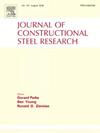收缩补偿uhpc填充钢管格构柱的压缩性能
IF 4
2区 工程技术
Q1 CONSTRUCTION & BUILDING TECHNOLOGY
引用次数: 0
摘要
本研究提出了一种新型的补偿收缩的超高性能钢管混凝土(UHPCFST)晶格柱系统,该系统解决了UHPC应用中的两个关键限制:通过在加入粗骨料的同时消除钢纤维来降低成本,并通过复合管状晶格配置提高结构效率。通过8个试件的轴压试验,包括5根UHPCFST格构柱、2根CFST格构柱和1根空心钢格构柱,对混凝土强度、钢纤维含量和钢管厚度三个关键参数的影响进行了评估。采用精细有限元模型进行了数值模拟,以补充实验研究。关键试验结果表明,增加钢管厚度和添加钢纤维可有效降低峰后荷载退化,而130 MPa uhpc填充试件的极限承载力分别比30 MPa混凝土和空心钢管试件高25%和79%。基于数值模拟的参数化分析表明,径厚比为主导因素,当径厚比从10增加到26.7时,极限承载力提高了416.8%。本文章由计算机程序翻译,如有差异,请以英文原文为准。
Compressive behavior of shrinkage-compensating UHPC-filled steel tube lattice columns
This study proposes a novel shrinkage-compensating ultra-high performance concrete-filled steel tube (UHPCFST) lattice column system that addresses two critical limitations in UHPC applications: cost reduction achieved by eliminating steel fibers while incorporating coarse aggregates, and enhanced structural efficiency through composite tubular lattice configuration. Axial compression tests on eight specimens comprising five UHPCFST lattice columns, two CFST lattice columns, and one hollow steel lattice column, were performed to evaluate the effects of three key parameters: concrete strength, steel fiber content, and steel tube thickness. Numerical simulations using refined finite element model were conducted to complement experimental investigations. The key test findings reveal that increasing steel tube thickness and adding steel fibers effectively reduced post-peak load degradation, while 130 MPa UHPC-filled specimen demonstrated 25 % and 79 % higher ultimate capacity than 30 MPa concrete-filled and hollow steel tube specimens, respectively. The parametric analysis based on numerical simulations identifies the diameter-to-thickness ratio as the dominant factor, with the ultimate capacity increasing 416.8 % when the ratio increases from 10 to 26.7.
求助全文
通过发布文献求助,成功后即可免费获取论文全文。
去求助
来源期刊

Journal of Constructional Steel Research
工程技术-工程:土木
CiteScore
7.90
自引率
19.50%
发文量
550
审稿时长
46 days
期刊介绍:
The Journal of Constructional Steel Research provides an international forum for the presentation and discussion of the latest developments in structural steel research and their applications. It is aimed not only at researchers but also at those likely to be most affected by research results, i.e. designers and fabricators. Original papers of a high standard dealing with all aspects of steel research including theoretical and experimental research on elements, assemblages, connection and material properties are considered for publication.
 求助内容:
求助内容: 应助结果提醒方式:
应助结果提醒方式:


